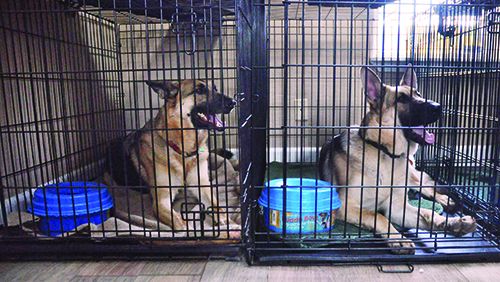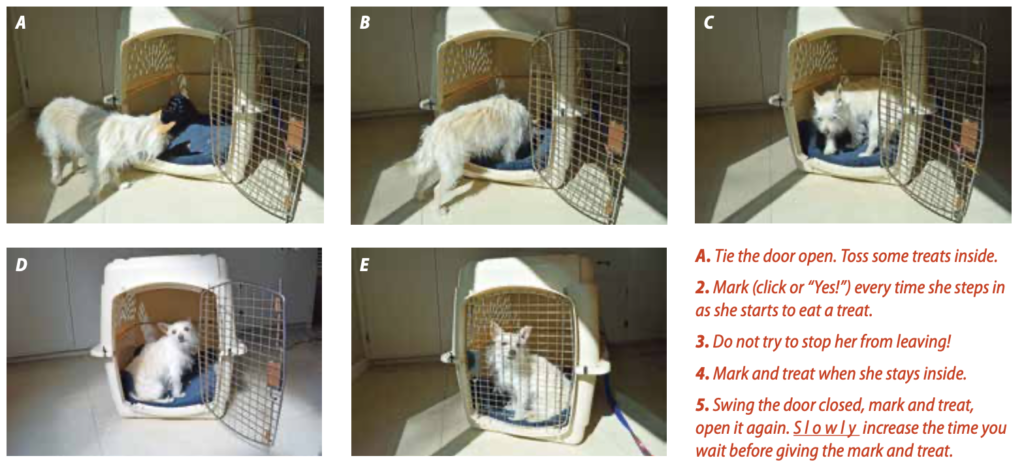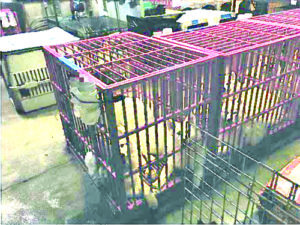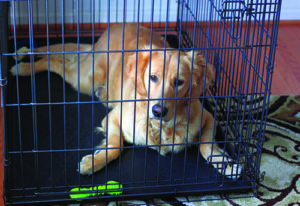
I first learned about crate-training for dogs in the early 1980s and have been a big fan ever since. There are many advantages to having a dog who is comfortable in her crate, not the least of which is puppy housetraining and management. Imagine my surprise then, when I recently discovered an increasingly loud, visible and growing opposition to crating. Granted, there’s an unfortunate amount of abusive crating out there, and that’s certainly not acceptable, but the vehement anti-craters are essentially opposed to any crating, ever. Seriously? Never?
CRATING BENEFITS
There are so many benefits to appropriate crating that I can’t list them all, but here are some of the most useful:
* Puppy housetraining and management. As mentioned above, housetraining for puppies (and even adult dogs) is greatly facilitated by the proper use of a crate. Since dogs have natural inhibitions against soiling their own dens, crating your pup for periods of time when she cannot be directly supervised, then taking her out to eliminate in her designated bathroom spot, can help her become reliably housetrained more quickly, with far fewer accidents. Crating also minimizes puppy chewing/destructive behaviors when direct supervision isn’t possible. Properly trained, most puppies and dogs can learn to see their crates as a very positive place.
* Restricted activity. Most dog owners are familiar with the dreaded words from their veterinarian following surgery or some other intensive medical treatment: “Your dog needs to be on restricted activity.” If your dog is already comfortable/happy being crated, a period of restricted activity is far less likely to be stressful to her (and to you!) and her rehabilitation is likely to be more successful. (See “Rest Easy,” WDJ August 2015.)
* Transportation. We know that there are significant risks posed by having loose dogs in a car – both from their potential to interfere with the driver and cause an accident, as well as the increased risk of injury or death to the dog if an accident occurs.
My own brother lost his lovely Australian Shepherd in a car wreck; she survived the accident but jumped out the smashed windshield and was killed by another car on the highway. A strapped-down crate (or a harness/seat belt combination) could have prevented her death.
* Canine classes and competition venues. There are a variety of canine classes and competition venues where dogs are routinely crated when it’s not their turn to work. It is generally expected that your dog can be crated when necessary.
* Behavior management. There are many situations in which a crate can be of great benefit for behavior management.
For example, our small mixed-breed, Sunny, constantly competes with Kai (our Kelpie) for attention, and because Kai consistently defers to Sunny, he tends to lose out in the attention game. We crate Sunny at night and Kai sleeps on the bed, so he gets an extended period of time with his humans without having to compete.
If one of your dogs has food-guarding issues, feeding one or both dogs in their crates can eliminate this source of tension. Some adult dogs still need to be confined for management purposes when their humans aren’t home, and some find their crates comforting during stressful events such as thunderstorms, fireworks, or visitors in the home. Others see it as the perfect place to stash their toys when they aren’t using them.
* Décor. No, I’m not kidding – there are actually some very stylish dog crates available that are useful when performing a double service as end tables, sideboards, coffee tables, corner cabinets, and more – you can decorate your house while you crate your dog!
HOW TO CRATE TRAIN
Here is a step-by-step guide for teaching your dog to love her crate. If at any time you get stuck in the process, don’t hesitate to contact a qualified force-free professional for help:
1. Start by leaving the crate in its intended long-term location with a soft blanket inside and some toys and treats on the blanket. The best introduction to the crate is when your dog can choose to explore it on her own. (Be sure to tie the door open so it won’t bang and frighten her.)
2. After she has had a chance to explore, with the crate door still tied open, toss some irresistibly yummy treats inside. If your dog is hesitant to go in after them, toss them close enough to the doorway that she can stand outside and just poke her nose into the crate to eat them. If you’re training with a clicker or other reward marker, use your marker each time she starts to eat the treat.
3. Gradually toss the treats farther into the crate until she will step inside to get them. Continue to mark each time she eats a treat. When she’ll enter the crate easily to get the treats, mark and offer a treat while she’s still inside. If she’s willing to stay inside, keep marking and treating.
If she comes out, that’s okay too, just toss another treat inside and wait for her to re-enter. Don’t ever try to force her to stay in the crate.
4. When she will enter the crate without hesitation, start using a verbal cue (such as “Go to bed!”) as she goes in, so that you will eventually be able to send her into the crate with just a verbal cue.
5. When she happily stays in the crate in anticipation of a mark and treat, gently move the door a little. Mark and treat. Gradually increase the movement until you are swinging the door all the way closed, using a mark (click or “Yes!”) and giving a treat with each swing. Don’t latch it! Mark and treat, then open the door.
Repeat this step, gradually increasing the length of time the door stays closed before you mark. Sometimes you can mark and reward without opening the door right away.
6. When your dog stays in the crate with the door closed for at least 10 seconds without any signs of anxiety, close the door, latch it, and take one step away from the crate. Mark, return to the crate, reward, and open the door. Repeat this step, varying the time and distance you leave the crate. Gradually increase the number of times you mark and treat without opening the door, but remember that a mark always gets a treat.
NOTE: Don’t make each of your dog’s stays in the crate longer and farther away from you; intersperse longer stays with shorter ones. Some dogs will grow increasingly apprehensive if they realize that each time they are in the crate, they will be “stuck” there for a longer period each time. Randomize the duration of each stay.

MORE TIPS
It’s a good idea to leave the crate open when you aren’t actively training. Toss treats and your dog’s favorite toys in the crate when she’s not looking, so she never knows what wonderful surprises she might find there. You can even feed her meals in the crate – with the door open – to help her realize that her crate is a truly wonderful place. With the door open, she can choose to relax in her crate whenever she wants.
There are many dogs and puppies who can do the whole crate training program in one day. Others may need practice over several days before they are completely comfortable entering and staying in the crate, and a few will take weeks or more. If your dog or puppy is one of the slower-to-love crating, you may need to use an exercise pen, instead, to contain her for management purposes.
If at any time during the program your dog whines or fusses about being in the crate, try to wait for a few seconds of quiet, then mark and reward. (If she won’t stop fussing, she is probably stressed and you will need to let her out despite her fussing.) Then, back up a step or two in the training program; you have made it too hard for her.
When she is doing well at that level again, increase the difficulty in smaller increments, and vary the times rather than constantly making it harder. For example, instead of going from five seconds to 10 to 15, start with five seconds, then seven, then three, then eight, then six, then four, then eight, and so on.
If, however, you believe your dog has a separation-related behavior, stop the crate training and consult a qualified force-free professional.
Once your dog is crate-trained, you have a valuable behavior management tool for life. Respect it. If you abuse your dog by keeping her confined too much, for too long a period of time, or by using it as punishment, you can easily ruin all the good work you’ve done, and lose the use of this invaluable tool. You really don’t want to do that!

Sadly, there are far too many readily available examples of improper and even abusive use of crates:
*Over-crating. Some owners crate too much because they don’t know any better. Just because your dog can “hold it” for 10 to 12 hours in his crate while you are at work, doesn’t mean he should have to. Anyone who has to leave their must-be-crated dog home for longer than four to five hours needs to find other options for a mid-day break for the dog. (Young puppies shouldn’t be asked to hold it longer than two to three hours during the day.) Options could include a family member, neighbor, or pet walker who can come by at mid day, a crate inside an exercise pen with the dog trained to use pee pads, or a well-run doggie daycare (young puppies generally should not go to daycare). Or perhaps a responsible friend, neighbor, or family member could provide daycare for your dog.
*Punishment. A dog’s crate should never be used as punishment – as in, “Bad dog, go to your crate!” The crate should be your dog’s happy place – not a place you send her to in anger. (Of course, we don’t advocate verbal or physical punishment anyway.) It is perfectly okay to use a crate as a temporary cheerful timeout: “Oh you need a break? Go to bed for a bit!” Nor should anyone, ever, punish the dog by thumping on the top of or shaking the crate.
*Teasing. A crate should be a safe place as well as a happy place. No teasing allowed – from thoughtless or wicked humans or from other dogs. If your dog must be crated where there is human foot traffic, set an exercise pen around her crate as a generous “air lock” so no one can get to her.
*Misguided behavior modification. A crate is the absolute wrong management or modification tool for most dogs with separation-related behaviors. (See “Amicable Separation,” June 2020.) The outdated adage to leave your anxious, stressed, screaming dog of any age alone and crated until they are quiet is hideous advice and likely to make your dog’s anxiety even worse. Dogs with moderate-to-serious separation stress are truly panicking when they are left alone, and dogs with these behaviors are notorious for not crating well.
Your job when crate training is to make it positive enough that your dog never has to bark in protest. If that’s not possible, there is likely a stress element involved, and you need to address that before you can even begin to crate-train.
*Hoarding. Bad breeders, rescue groups, shelters, and even foster providers sometimes keep dogs in crates 24 hours a day, with occasional bathroom breaks if they are lucky. These are situations that are better referred as “hoarders.” No dog should live in his own urine and feces in a crate. No dog should live in a crate 24/7 even if he does get out often enough to avoid soiling his den. Period.
IF ALL ELSE FAILS, USE OTHER OPTIONS
So, if you crate (and I do!), do it right. Consider whether you have other options, either temporary or long term. When we first adopted our dog Sunny, he had not been crate trained and he had some (fortunately mild) separation-related behaviors that ruled out crating as an option. For the first few months, he slept in an exercise pen next to my bed, initially with my arm draped over the side to reassure him that I was close by.
Over a period of weeks, I was gradually able to remove my arm from the pen and start moving the pen farther and farther from the side of the bed. Our bedroom is really too small to comfortably accommodate a crate, so he was eventually crate-trained and now sleeps happily in his crate.
However, Sunny is still not 100% trustworthy loose in the house, so when I leave him alone, he is shut in my office (spacious compared to a crate!) to keep him out of trouble, usually with his brother Kai, and all is well. We’ve even been able to remove the barriers that were originally put in place to prevent him from chewing up all my books. Be a creative minimalist with your crate use!

There are a number of things you can do to make your dog’s crating experience more successful and more positive for her.
• If your dog has had past unpleasant experiences with crating, consider changes. If you were using an airline crate, try a wire crate. Try offering two or three different types of crates and see if she shows a crate-style preference. If she was crated in the living room, try the den. If she gets aroused by outside stimuli, move the crate away from the front door to an isolated, quiet location in the house.
• Make sure your dog’s crate is placed in an environmentally comfortable location. You may not realize that the sun comes through the living room window and hits the crate at 1 p.m., causing your dog to overheat, or perhaps there’s a draft from an open window that makes her uncomfortably cold. Try putting several crates in different locations and see if she shows a location preference.
• Respect your dog’s preference for bedding. She may love a cushy comforter to lie on while crated – or she may prefer the coolness of a bare crate floor. Accommodate her wishes! Try offering two crates with different types of flooring/bedding and see if she chooses one over the other.
• Consider giving your dog more spacious accommodations. When housetraining, we want the crate to be just large enough to stand up, turn around, and lie down comfortably, so she can’t soil one end and rest comfortably in the other. After she is housetrained, however, there is no need to keep her in a small space. If you have the room, give her luxury accommodations!
Author Pat Miller, CBCC-KA, CPDT‑KA, is WDJ’s Training Editor. She and her husband live in Fairplay, Maryland, site of her Peaceable Paws training center. Miller has written many books, including How to Foster Dogs: From Homeless to Homeward Bound and Do Over Dogs: Give Your Dog a Second Chance for a First Class Life. See “Resources,” page 24, for information on her books, classes for dog owners, and academies for dog trainers.






I also crate my dog and usually have a dog walker who takes my dog out but now my kids are out of school so my kids are the ones who looks after our dog while I’m not there.
Such an informative post! Thank you!
My two year old spaniel loves his crate,used it from he was eight weeks old.Left open all day he sometimes goes in but has more then one bed and chair around the house!!
My query is his crate is coved with a light blanket at night, no problem he comes around 11 pm to go out and straight into his crate with a couple of treats always sleeps until around 7am but a number of people have made negative comments on his crater being covered at night.Am I doing wrong covering him at his age.
Any advise welcome.
It’s a very good article thank you….